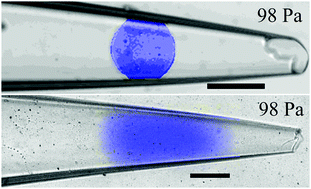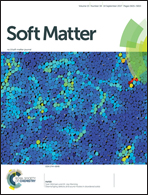Generation and characterization of monodisperse deformable alginate and pNIPAM microparticles with a wide range of shear moduli†
Abstract
Monodisperse particles of varying size, shape, and deformability were produced using two microfluidic strategies. For both strategies, monodisperse emulsion droplets of a crosslinkable solution were generated via flow-focusing. Subsequently, droplets were crosslinked either on chip or in an external bath. On-chip gelation resulted in spherical particles; varying the degree of crosslinking varied the deformability systematically. The optimized flow-focusing device design separated the production of monodisperse aqueous alginate droplets and the on-chip introduction of crosslinking ions. Two features were then adapted to target softer particles: the dispersed phase design and the polymer choice. The alternative design used a sheathed dispersed phase, with the polymer solution surrounding an unreactive viscous core, which generated alginate particles with a softer core. Poly(N-isopropylacrylamide) (pNIPAM) allowed access to a broad range of moduli. The resulting spherical particles were characterized using capillary micromechanics to determine the shear (G) and compressive (K) moduli. Particles with G = 0.013 kPa to 26 kPa and K = 0.221 kPa to 34.9 kPa were obtained; the softest particles are an order of magnitude softer than those previously reported. The second approach, based on earlier work by Hu et al., produced axisymmetric, non-spherical particles with fore-aft asymmetry. Alginate drops were again formed in a flow-focusing device but were crosslinked off-chip in an external gelation bath. By changing the bath viscosity, crosslinker concentration, and outlet height, the falling droplets deformed differently during gelation, resulting in a variety of shapes, such as teardrop, mushroom, and bowl shapes.



 Please wait while we load your content...
Please wait while we load your content...